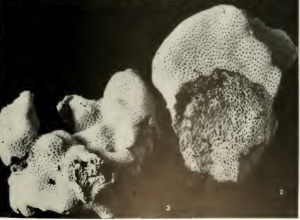Author: Tom Bridge
Species: Pavona duerdeni Vaughan 1907
Pavona duerdeni is regarded as a distinctive species. The intricate thamnasteroid (or ‘star-shaped) corallites (see Rosen 1986) of this species clearly identify it as a member of the family Agariciidae, but the most distinctive feature of the species, at least as interpreted in recent decades (e.g. Veron 2000), is its growth form. It is described as forming large colonies composed of thick parallel ridges or ‘blades’ which may be several metres across. This unique growth form makes it easy to distinguish from all other Agariciids – even Pavona clavus Dana 1846, which also forms large colonies but is generally columnar rather than clade-shaped.
Despite being considered distinctive, P. duerdeni has had a complex taxonomic history. The species was originally described by Vaughan (1907) from Molokai in the main Hawaiian Islands, who describes it as forming ‘plates a centimeter thick or somewhat more, or as an irregular nodose mass’. Vaughan also remarks on ‘a decidedly puzzling group of species, apparently belonging to the genus Pavona, comprising P. clavus from Fiji along with undescribed species in the USNM collections from the central Pacific. Veron and Pichon (1976) and Veron (1986) considered P. duerdeni a junior synonym of P. clavus. However, Veron (1986) also included a photo of what is now considered P. duerdeni in his description of P. minuta Wells 1954. In Veron (2000) the blade-like species is identified as P. duerdeni. You can see that coral taxonomy is a tough gig when one person calls the same species three different things over the course of 25 years.
Veron (2000) also suggests that this species is among the most widely-distributed of all coral species, occurring from Baja California in the eastern Pacific, right across the Pacific and Indian Oceans to subtropical South Africa, as far north as Kyushu in subtropical Japan and south to Lord Howe Island, the world’s southernmost coral reef.
But are things really what they seem? Specimens considered P. duerdeni from a range of locations across the Pacific certainly seem to share very similar corallites to the type specimen from Hawaii. However, the Hawaiian Islands are known for their high endemism across a wide range of marine and terrestrial taxa, owing to their isolated location in the north-eastern Pacific. While most corals are considered to have wide geographic ranges based on traditional morphological taxonomy, Hawaii is known to support endemic species (e.g. Porites compressa Dana 1846 and P. brighami Vaughan 1907). Furthermore, recent genetic evidence is showing that morphological convergence has obscured strong geographic structure within putatively widespread coral species. Consequently, while species resembling P. duerdeni undoubtedly occur across the Indo-Pacific, it seems unlikely that they would all belong to a single pandemic species. The only way to comprehensively resolve these questions is to conduct molecular analysis of specimens collected from across the entire range of the species. If highly divergent lineages are identified, it may be possible to identify morphological characters indicative of species boundaries. However, it is possible that P. duerdeni may provide a text book example of true ‘cryptic speciation’, where deeply divergent species cannot be distinguished based on morphological characters. Unlike P. clavus, there are no junior synonyms of P. duerdeni, so any species identified as distinct from Hawaiian P. duerdeni would represent a new, undescribed species.
Literature cited
Veron JEN, Wallace CC (1984) Scleractinia of Eastern Australia – Part V. Family Acroporidae. Australian Institute of Marine Science Monograph Series 6: 1–485
Dana, J. D. (1846). Zoophytes. United States Exploring Expedition during the years 1838-1842. Lea and Blanchard, Philadelphia. 7: 1-740
Rosen BR (1986) Modular growth and form of corals: A matter of metamers. Philosophical transactions of the Royal Society of London B: Biological Sciences 313: 115-142
Vaughan TW (1907) Recent Madreporaria of the Hawaiian Islands and Laysan. US National Museum Bulletin. 59 (9): 1-427.
Veron JEN, Pichon M. (1976). Scleractinia of Eastern Australia. Part I. Families Thamnasteriidae, Astroceoniidae, Pocilloporidae. Australian Institute of Marine Science Monograph Series. 1: 1-86.
Veron JEN. (1986). Corals of Australia and the Indo-Pacific. Angus & Robertson Publishers.
Veron JEN. (2000). Corals of the World. Vol. 1–3. Australian Institute of Marine Science and CRC, Queensland, Australia.
Wells, J. W. (1954). Recent corals of the Marshall Islands. Bikini and nearby atolls, Part 2, Oceanography (Biology). U.S. Geological Survey Professional Papers. 260-1, pls. 94-185




